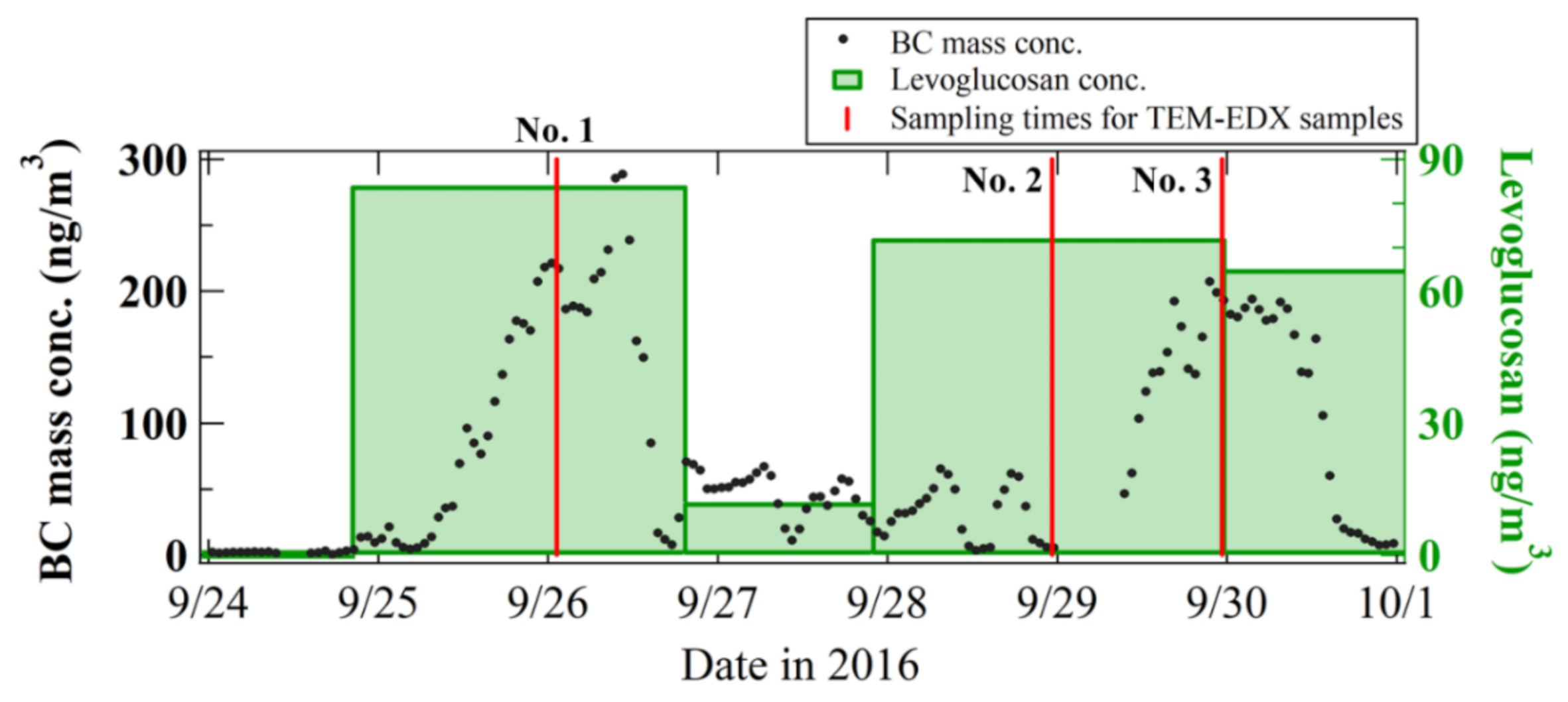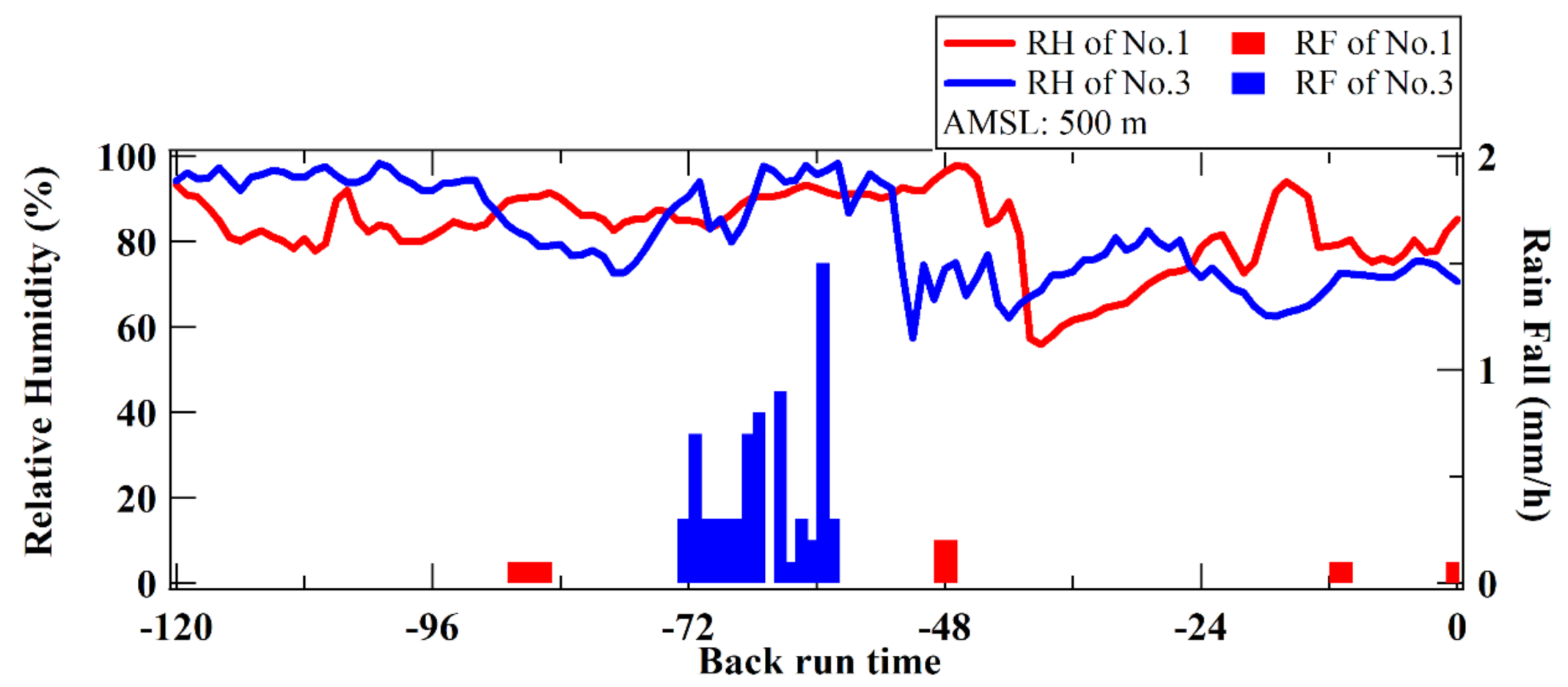Detection of Aerosol Particles from Siberian Biomass Burning over the Western North Pacific
Abstract
1. Introduction
2. Materials and Analysis
2.1. Observations and Sampling
2.2. TEM Analysis
3. Results and Discussion
3.1. Estimates of the Origins of Air Masses during Sampling for TEM-EDX Analysis
3.2. Individual Particle Analyses
3.3. Morphological and Elemental Characteristics of the TBs
4. Summary
Supplementary Materials
Author Contributions
Funding
Acknowledgments
Conflicts of Interest
References
- Bond, T.C.; Bergstrom, R.W. Light absorption by carbonaceous particles: An investigative review. Aerosol Sci. Technol. 2006, 40, 27–67. [Google Scholar] [CrossRef]
- Harvey, B.J. Human-caused climate change is now a key driver of forest fire activity in the western United States. Proc. Natl. Acad. Sci. USA 2016, 113, 11649–11650. [Google Scholar] [CrossRef] [PubMed]
- Bond, T.C.; Doherty, S.J.; Fahey, D.W.; Forster, P.M.; Berntsen, T.; DeAngelo, B.J.; Flanner, M.G.; Ghan, S.; Kärcher, B.; Koch, D.; et al. Bounding the role of black carbon in the climate system: A scientific assessment. J. Geophys. Res. Atmos. 2013, 118, 5380–5552. [Google Scholar] [CrossRef]
- Pósfai, M.; Gelencsér, A.; Simonics, R.; Arató, K.; Li, J.; Hobbs, P.V.; Buseck, P.R. Atmospheric tar balls: Particles from biomass and biofuel burning. J. Geophys. Res. 2004, 109, D06213. [Google Scholar] [CrossRef]
- Hand, J.L.; Malm, W.C.; Laskin, A.; Day, D.; Lee, T.; Wang, C.; Carrico, C.; Carrillo, J.; Cowin, J.P.; Collett, J., Jr.; et al. Optical, physical, and chemical properties of tar balls observed during the Yosemite Aerosol Characterization Study. J. Geophys. Res. 2005, 110, D21210. [Google Scholar] [CrossRef]
- Adachi, K.; Buseck, P.R. Atmospheric tar balls from biomass burning in Mexico. J. Geophys. Res. Atmos. 2011, 116, D05204. [Google Scholar] [CrossRef]
- Girotto, G.; China, S.; Bhandari, J.; Gorkowski, K.; Scarnato, B.V.; Capek, T.; Marinoni, A.; Veghte, D.P.; Kulkarni, G.; Aiken, A.C.; et al. Fractal-like Tar Ball Aggregates from Wildfire Smoke. Environ. Sci. Technol. Lett. 2018, 5, 360–365. [Google Scholar] [CrossRef]
- Sedlacek III, A.J.; Buseck, P.R.; Adachi, K.; Onasch, T.B.; Springston, S.R.; Kleinman, L. Formation and evolution of tar balls from northwestern US wildfires. Atmos. Chem. Phys. 2018, 18, 11289–11301. [Google Scholar] [CrossRef]
- Adachi, K.; Sedlacek III, A.J.; Kleinman, L.; Springston, S.R.; Wangb, J.; Chand, D.; Hubbe, J.M.; Shilling, J.E.; Onasch, T.B.; Kinase, T.; et al. Spherical tarball particles form through rapid chemical and physical changes of organic matter in biomass-burning smoke. Proc. Natl. Acad. Sci. USA 2019, 116, 19336–19341. [Google Scholar] [CrossRef]
- Chakrabarty, R.K.; Moosmüller, H.; Chen, L.-W.A.; Lewis, K.; Arnott, W.P.; Mazzoleni, C.; Dubey, M.K.; Wold, C.E.; Hao, W.M.; Kreidenweis, S.M. Brown carbon in tar balls from smoldering biomass combustion. Atmos. Chem. Phys. 2010, 10, 6363–6370. [Google Scholar] [CrossRef]
- Chung, C.E.; Ramanathan, V.; Decremer, D. Observationally constrained estimates of carbonaceous aerosol radiative forcing. Proc. Natl. Acad. Sci. USA 2012, 109, 11624–11629. [Google Scholar] [CrossRef] [PubMed]
- Jaffe, D.; Bertschi, I.; Jaeglé, L.; Norelli, P.; Reid, J.S.; Tanimoto, H.; Vingarzan, R.; Westphal, L.W. Long-range transport of Siberian biomass burning emissions and impact on surface ozone in western North America. Gephys. Res. Lett. 2004, 31, L16106. [Google Scholar] [CrossRef]
- Warneke, C.; Froyd, K.D.; Brioude, J.; Bahreini, R.; Brock, C.A.; Cozic, J.; Gouw, J.A.; Fahey, D.W.; Ferrare, R.; Holloway, J.S.; et al. An important contribution to springtime Arctic aerosol from biomass burning in Russia. Geophys. Res. Lett. 2010, 37, L01801. [Google Scholar] [CrossRef]
- Ritter, C.; Notholt, J.; Fischer, J.; Rathke, C. Direct thermal radiative forcing of tropospheric aerosol in the Arctic measured by ground based infrared spectrometry. Geophys. Res. Lett. 2005, 32, L23816. [Google Scholar] [CrossRef]
- Flanner, M.G.; Zender, C.S.; Randerson, J.T.; Rasch, P.J. Present-day climate forcing and response from black carbon in snow. J. Geophys. Res. 2007, 112, D11202. [Google Scholar] [CrossRef]
- Tohjima, Y.; Zeng, J.; Shirai, T.; Niwa, Y.; Ishidoya, S.; Taketani, F.; Sasano, D.; Kosugi, N.; Kameyama, S.; Takashima, H.; et al. Estimation of CH4 emissions from the East Siberian Arctic Shelf based on atmospheric observations aboard the R/V Mirai during fall cruises from 2012 to 2017. Polar Sci. 2020, in press. [Google Scholar] [CrossRef]
- Yoshizue, M.; Iwamoto, Y.; Adachi, K.; Kato, S.; Sun, S.; Miura, K.; Uematsu, M. Individual particle analysis of marine aerosols collected during the North–South transect cruise in the Pacifc Ocean and its marginal seas. J. Oceanogr. 2019, 75, 513–524. [Google Scholar] [CrossRef]
- Taketani, F.; Miyakawa, T.; Takigawa, M.; Yamaguchi, M.; Komazaki, Y.; Mordovskoi, P.; Takashima, H.; Nishino, S.; Tohjima, Y.; Kanaya, Y. Characteristics of atmospheric aerosol particles over the Arctic Ocean in early autumn 2016. Atmos. Environ. 2020. to be submitted. [Google Scholar]
- NOAA Air Resources Laboratory (ARL) for the Provision of the HYSPLIT Transport and Dispersion Model and/or READY. Available online: http://www.ready.noaa.gov/HYSPLIT.php (accessed on 22 September 2020).
- Rolph, G.; Stein, A.; Stunder, B. Real-time Environmental Applications and Display sYstem: READY. Environ. Model. Softw. 2017, 95, 210–228. [Google Scholar] [CrossRef]
- Stein, A.F.; Draxler, R.R.; Rolph, G.D.; Stunder, B.J.B.; Cohen, M.D.; Ngan, F. NOAA’s HYSPLIT atmospheric transport and dispersion modeling system. Bull. Am. Meteor. Soc. 2015, 96, 2059–2077. [Google Scholar] [CrossRef]
- Fire Information for Resource Management System. Available online: https://firms.modaps.eosdis.nasa.gov/map/ (accessed on 22 September 2020).
- Simoneit, B.R.T.; Schocer, J.J.; Notle, C.G.; Oros, D.R.; Elias, V.O.; Fraser, M.P.; Rogge, W.F.; Cass, G.R. Levoglucosan, a tracer for cellulose in biomass burning and atmospheric particles. Atmos. Environ. 1999, 33, 173–182. [Google Scholar] [CrossRef]
- Schauer, J.J.; Kleeman, M.J.; Cass, G.R.; Simoneit, B.R.T. Measurement of Emissions from Air Pollution Sources. 3. C1−C29 Organic Compounds from Fireplace Combustion of Wood. Environ. Sci. Technol. 2001, 35, 1716–1728. [Google Scholar] [CrossRef]
- Cachier, H.; Liousse, C.; Buatmenard, P.; Gaudichet, A. Particulate Content of Savanna Fire Emissions. J. Atmos. Chem. 1995, 22, 123–148. [Google Scholar] [CrossRef]
- Abbatt, J.P.D.; Leaitch, W.R.; Aliabadi, A.A.; Bertram, A.K.; Blanchet, J.-P.; Boivin-Rioux, A.; Bozem, H.; Burkart, J.; Chang, R.Y.W.; Charette, J.; et al. Overview paper: New insights into aerosol and climate in the Arctic. Atmos. Chem. Phys. 2019, 19, 2527–2560. [Google Scholar] [CrossRef]
- Warneke, C.; Bahreini, R.; Brioude, J.; Brock, C.A.; de Gouw, J.A.; Fahey, D.W.; Froyd, K.D.; Holloway, J.S.; Middlebrook, A.; Miller, L.; et al. Biomass burning in Siberia and Kazakhstan as an important source for haze over the Alaskan Arctic in April 2008. Geophys. Res. Lett. 2009, 36, L02813. [Google Scholar] [CrossRef]






Publisher’s Note: MDPI stays neutral with regard to jurisdictional claims in published maps and institutional affiliations. |
© 2020 by the authors. Licensee MDPI, Basel, Switzerland. This article is an open access article distributed under the terms and conditions of the Creative Commons Attribution (CC BY) license (http://creativecommons.org/licenses/by/4.0/).
Share and Cite
Yoshizue, M.; Taketani, F.; Adachi, K.; Iwamoto, Y.; Tohjima, Y.; Mori, T.; Miura, K. Detection of Aerosol Particles from Siberian Biomass Burning over the Western North Pacific. Atmosphere 2020, 11, 1175. https://doi.org/10.3390/atmos11111175
Yoshizue M, Taketani F, Adachi K, Iwamoto Y, Tohjima Y, Mori T, Miura K. Detection of Aerosol Particles from Siberian Biomass Burning over the Western North Pacific. Atmosphere. 2020; 11(11):1175. https://doi.org/10.3390/atmos11111175
Chicago/Turabian StyleYoshizue, Momoka, Fumikazu Taketani, Kouji Adachi, Yoko Iwamoto, Yasunori Tohjima, Tatsuhiro Mori, and Kazuhiko Miura. 2020. "Detection of Aerosol Particles from Siberian Biomass Burning over the Western North Pacific" Atmosphere 11, no. 11: 1175. https://doi.org/10.3390/atmos11111175
APA StyleYoshizue, M., Taketani, F., Adachi, K., Iwamoto, Y., Tohjima, Y., Mori, T., & Miura, K. (2020). Detection of Aerosol Particles from Siberian Biomass Burning over the Western North Pacific. Atmosphere, 11(11), 1175. https://doi.org/10.3390/atmos11111175




